Public Relations Assignment: History, Ethics, Models, and Systems
VerifiedAdded on 2023/06/04
|9
|2145
|150
Homework Assignment
AI Summary
This document presents a comprehensive solution to a public relations assignment, addressing key concepts such as the history and development of public relations, ethical considerations through case studies, and the application of various public relations models, specifically focusing on the TD Canada Trust. The assignment delves into the historical evolution of PR, highlighting the contributions of key practitioners and providing examples to illustrate the practice's progression. It also analyzes ethical dilemmas in the field using case studies, applying ethical frameworks such as utilitarian, deontological, and virtue theories, alongside professional codes like IABC and CPRS. Furthermore, the assignment explores the four models of PR within the context of TD Canada Trust, emphasizing the application of systems theory to understand the organization's relationship with its environment. The document analyzes how systems theory aids in understanding the organization's interactions with its micro and macro environments. References are provided in APA format.

Running Head: PUBLIC RELATIONS 1
Public relations
Name
Institution
Professor
Course
Date
Public relations
Name
Institution
Professor
Course
Date
Paraphrase This Document
Need a fresh take? Get an instant paraphrase of this document with our AI Paraphraser
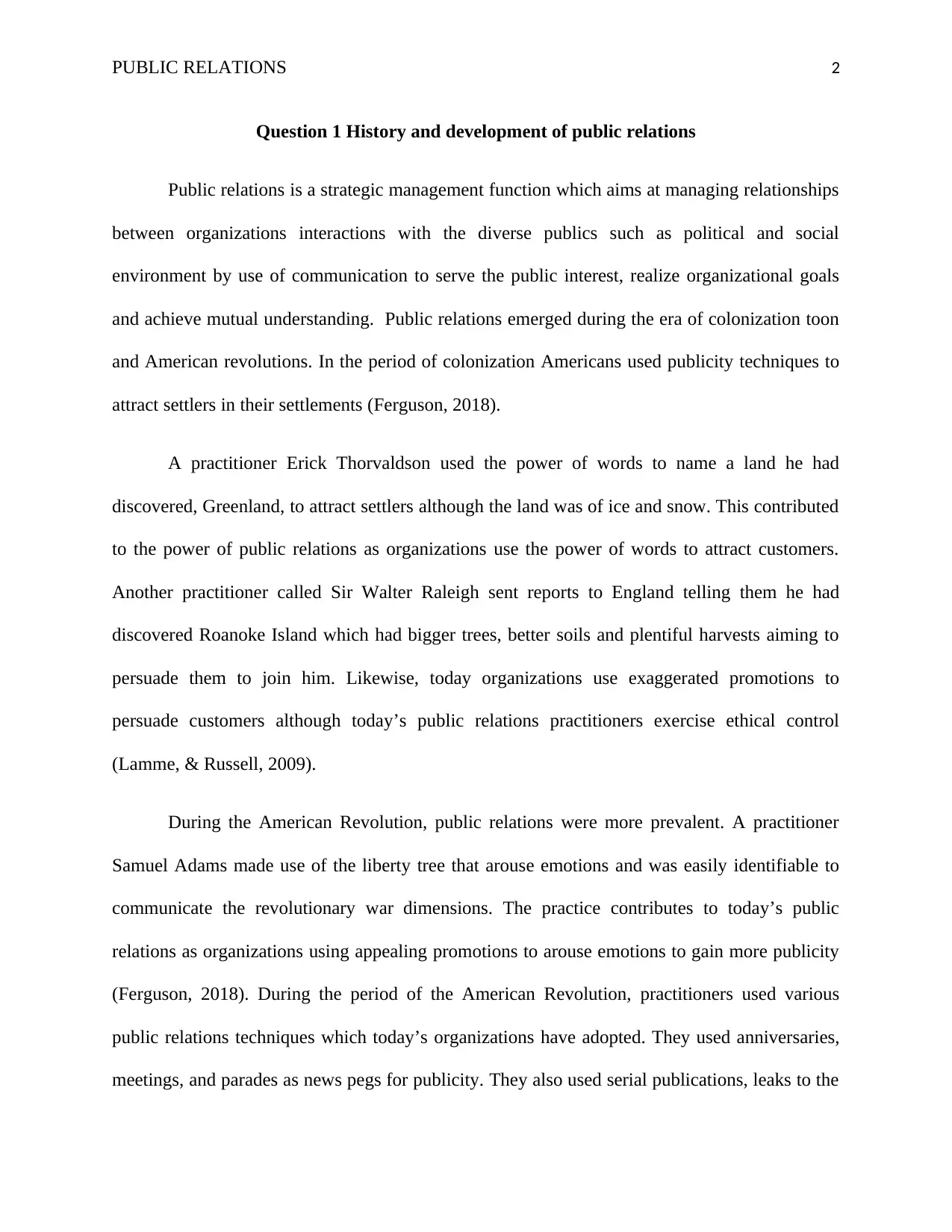
PUBLIC RELATIONS 2
Question 1 History and development of public relations
Public relations is a strategic management function which aims at managing relationships
between organizations interactions with the diverse publics such as political and social
environment by use of communication to serve the public interest, realize organizational goals
and achieve mutual understanding. Public relations emerged during the era of colonization toon
and American revolutions. In the period of colonization Americans used publicity techniques to
attract settlers in their settlements (Ferguson, 2018).
A practitioner Erick Thorvaldson used the power of words to name a land he had
discovered, Greenland, to attract settlers although the land was of ice and snow. This contributed
to the power of public relations as organizations use the power of words to attract customers.
Another practitioner called Sir Walter Raleigh sent reports to England telling them he had
discovered Roanoke Island which had bigger trees, better soils and plentiful harvests aiming to
persuade them to join him. Likewise, today organizations use exaggerated promotions to
persuade customers although today’s public relations practitioners exercise ethical control
(Lamme, & Russell, 2009).
During the American Revolution, public relations were more prevalent. A practitioner
Samuel Adams made use of the liberty tree that arouse emotions and was easily identifiable to
communicate the revolutionary war dimensions. The practice contributes to today’s public
relations as organizations using appealing promotions to arouse emotions to gain more publicity
(Ferguson, 2018). During the period of the American Revolution, practitioners used various
public relations techniques which today’s organizations have adopted. They used anniversaries,
meetings, and parades as news pegs for publicity. They also used serial publications, leaks to the
Question 1 History and development of public relations
Public relations is a strategic management function which aims at managing relationships
between organizations interactions with the diverse publics such as political and social
environment by use of communication to serve the public interest, realize organizational goals
and achieve mutual understanding. Public relations emerged during the era of colonization toon
and American revolutions. In the period of colonization Americans used publicity techniques to
attract settlers in their settlements (Ferguson, 2018).
A practitioner Erick Thorvaldson used the power of words to name a land he had
discovered, Greenland, to attract settlers although the land was of ice and snow. This contributed
to the power of public relations as organizations use the power of words to attract customers.
Another practitioner called Sir Walter Raleigh sent reports to England telling them he had
discovered Roanoke Island which had bigger trees, better soils and plentiful harvests aiming to
persuade them to join him. Likewise, today organizations use exaggerated promotions to
persuade customers although today’s public relations practitioners exercise ethical control
(Lamme, & Russell, 2009).
During the American Revolution, public relations were more prevalent. A practitioner
Samuel Adams made use of the liberty tree that arouse emotions and was easily identifiable to
communicate the revolutionary war dimensions. The practice contributes to today’s public
relations as organizations using appealing promotions to arouse emotions to gain more publicity
(Ferguson, 2018). During the period of the American Revolution, practitioners used various
public relations techniques which today’s organizations have adopted. They used anniversaries,
meetings, and parades as news pegs for publicity. They also used serial publications, leaks to the
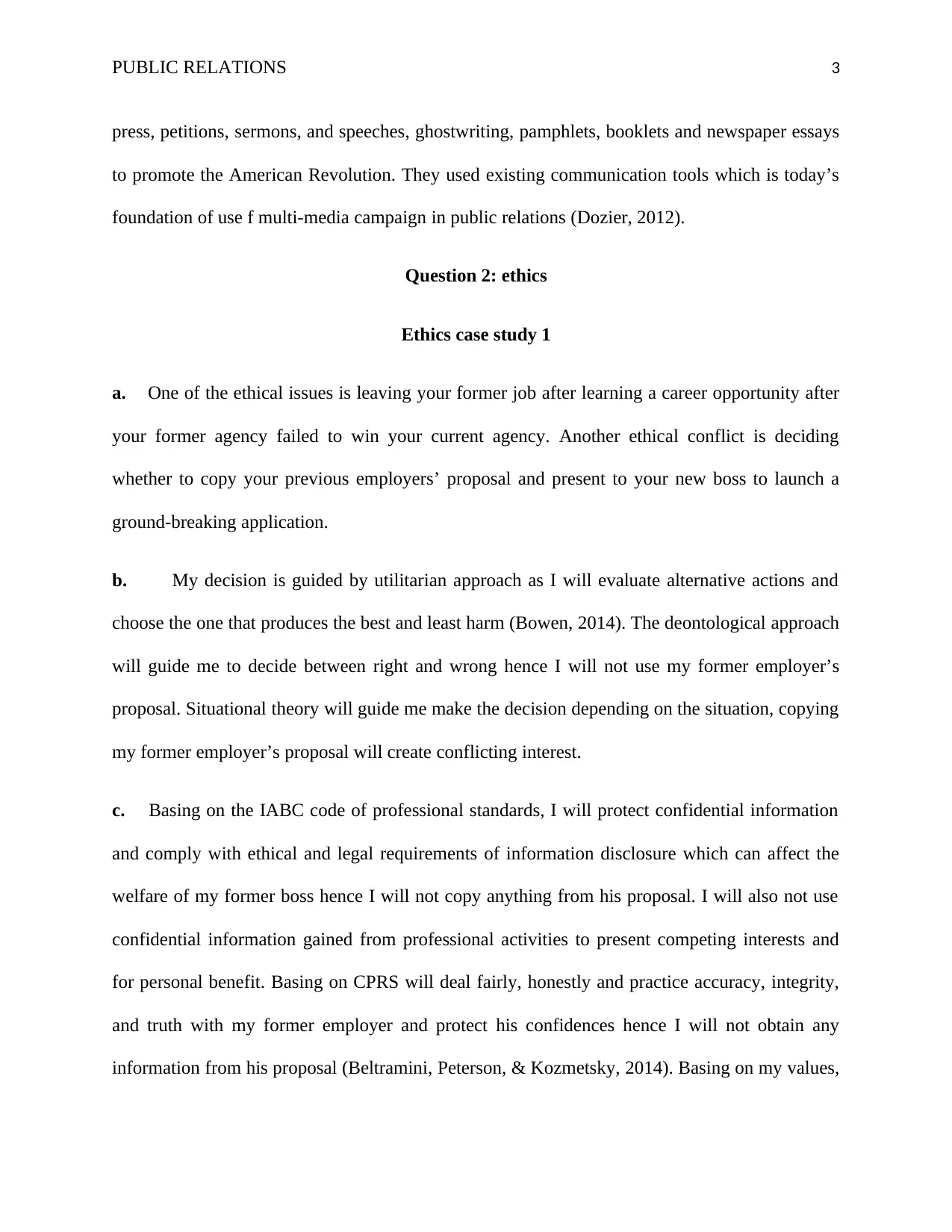
PUBLIC RELATIONS 3
press, petitions, sermons, and speeches, ghostwriting, pamphlets, booklets and newspaper essays
to promote the American Revolution. They used existing communication tools which is today’s
foundation of use f multi-media campaign in public relations (Dozier, 2012).
Question 2: ethics
Ethics case study 1
a. One of the ethical issues is leaving your former job after learning a career opportunity after
your former agency failed to win your current agency. Another ethical conflict is deciding
whether to copy your previous employers’ proposal and present to your new boss to launch a
ground-breaking application.
b. My decision is guided by utilitarian approach as I will evaluate alternative actions and
choose the one that produces the best and least harm (Bowen, 2014). The deontological approach
will guide me to decide between right and wrong hence I will not use my former employer’s
proposal. Situational theory will guide me make the decision depending on the situation, copying
my former employer’s proposal will create conflicting interest.
c. Basing on the IABC code of professional standards, I will protect confidential information
and comply with ethical and legal requirements of information disclosure which can affect the
welfare of my former boss hence I will not copy anything from his proposal. I will also not use
confidential information gained from professional activities to present competing interests and
for personal benefit. Basing on CPRS will deal fairly, honestly and practice accuracy, integrity,
and truth with my former employer and protect his confidences hence I will not obtain any
information from his proposal (Beltramini, Peterson, & Kozmetsky, 2014). Basing on my values,
press, petitions, sermons, and speeches, ghostwriting, pamphlets, booklets and newspaper essays
to promote the American Revolution. They used existing communication tools which is today’s
foundation of use f multi-media campaign in public relations (Dozier, 2012).
Question 2: ethics
Ethics case study 1
a. One of the ethical issues is leaving your former job after learning a career opportunity after
your former agency failed to win your current agency. Another ethical conflict is deciding
whether to copy your previous employers’ proposal and present to your new boss to launch a
ground-breaking application.
b. My decision is guided by utilitarian approach as I will evaluate alternative actions and
choose the one that produces the best and least harm (Bowen, 2014). The deontological approach
will guide me to decide between right and wrong hence I will not use my former employer’s
proposal. Situational theory will guide me make the decision depending on the situation, copying
my former employer’s proposal will create conflicting interest.
c. Basing on the IABC code of professional standards, I will protect confidential information
and comply with ethical and legal requirements of information disclosure which can affect the
welfare of my former boss hence I will not copy anything from his proposal. I will also not use
confidential information gained from professional activities to present competing interests and
for personal benefit. Basing on CPRS will deal fairly, honestly and practice accuracy, integrity,
and truth with my former employer and protect his confidences hence I will not obtain any
information from his proposal (Beltramini, Peterson, & Kozmetsky, 2014). Basing on my values,
⊘ This is a preview!⊘
Do you want full access?
Subscribe today to unlock all pages.

Trusted by 1+ million students worldwide
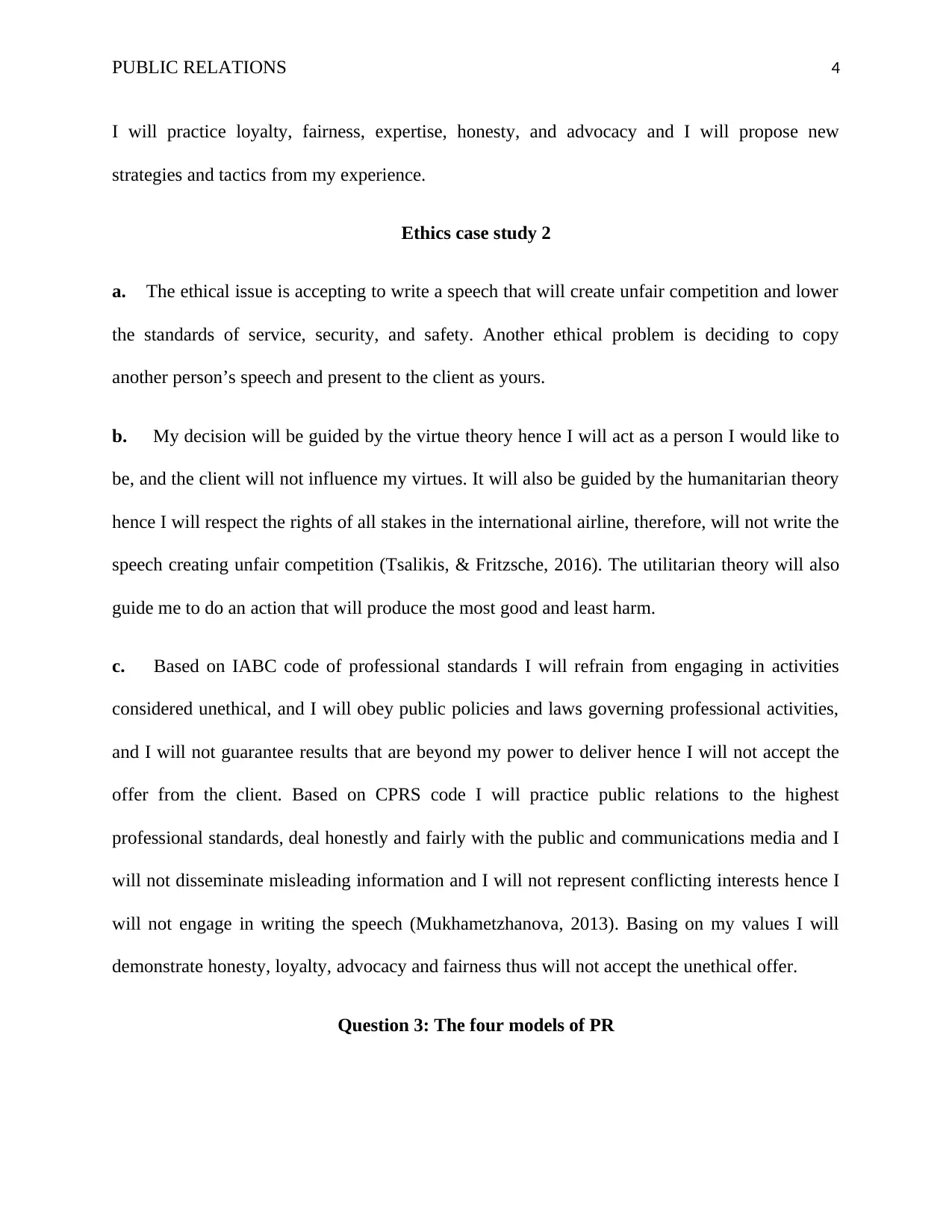
PUBLIC RELATIONS 4
I will practice loyalty, fairness, expertise, honesty, and advocacy and I will propose new
strategies and tactics from my experience.
Ethics case study 2
a. The ethical issue is accepting to write a speech that will create unfair competition and lower
the standards of service, security, and safety. Another ethical problem is deciding to copy
another person’s speech and present to the client as yours.
b. My decision will be guided by the virtue theory hence I will act as a person I would like to
be, and the client will not influence my virtues. It will also be guided by the humanitarian theory
hence I will respect the rights of all stakes in the international airline, therefore, will not write the
speech creating unfair competition (Tsalikis, & Fritzsche, 2016). The utilitarian theory will also
guide me to do an action that will produce the most good and least harm.
c. Based on IABC code of professional standards I will refrain from engaging in activities
considered unethical, and I will obey public policies and laws governing professional activities,
and I will not guarantee results that are beyond my power to deliver hence I will not accept the
offer from the client. Based on CPRS code I will practice public relations to the highest
professional standards, deal honestly and fairly with the public and communications media and I
will not disseminate misleading information and I will not represent conflicting interests hence I
will not engage in writing the speech (Mukhametzhanova, 2013). Basing on my values I will
demonstrate honesty, loyalty, advocacy and fairness thus will not accept the unethical offer.
Question 3: The four models of PR
I will practice loyalty, fairness, expertise, honesty, and advocacy and I will propose new
strategies and tactics from my experience.
Ethics case study 2
a. The ethical issue is accepting to write a speech that will create unfair competition and lower
the standards of service, security, and safety. Another ethical problem is deciding to copy
another person’s speech and present to the client as yours.
b. My decision will be guided by the virtue theory hence I will act as a person I would like to
be, and the client will not influence my virtues. It will also be guided by the humanitarian theory
hence I will respect the rights of all stakes in the international airline, therefore, will not write the
speech creating unfair competition (Tsalikis, & Fritzsche, 2016). The utilitarian theory will also
guide me to do an action that will produce the most good and least harm.
c. Based on IABC code of professional standards I will refrain from engaging in activities
considered unethical, and I will obey public policies and laws governing professional activities,
and I will not guarantee results that are beyond my power to deliver hence I will not accept the
offer from the client. Based on CPRS code I will practice public relations to the highest
professional standards, deal honestly and fairly with the public and communications media and I
will not disseminate misleading information and I will not represent conflicting interests hence I
will not engage in writing the speech (Mukhametzhanova, 2013). Basing on my values I will
demonstrate honesty, loyalty, advocacy and fairness thus will not accept the unethical offer.
Question 3: The four models of PR
Paraphrase This Document
Need a fresh take? Get an instant paraphrase of this document with our AI Paraphraser
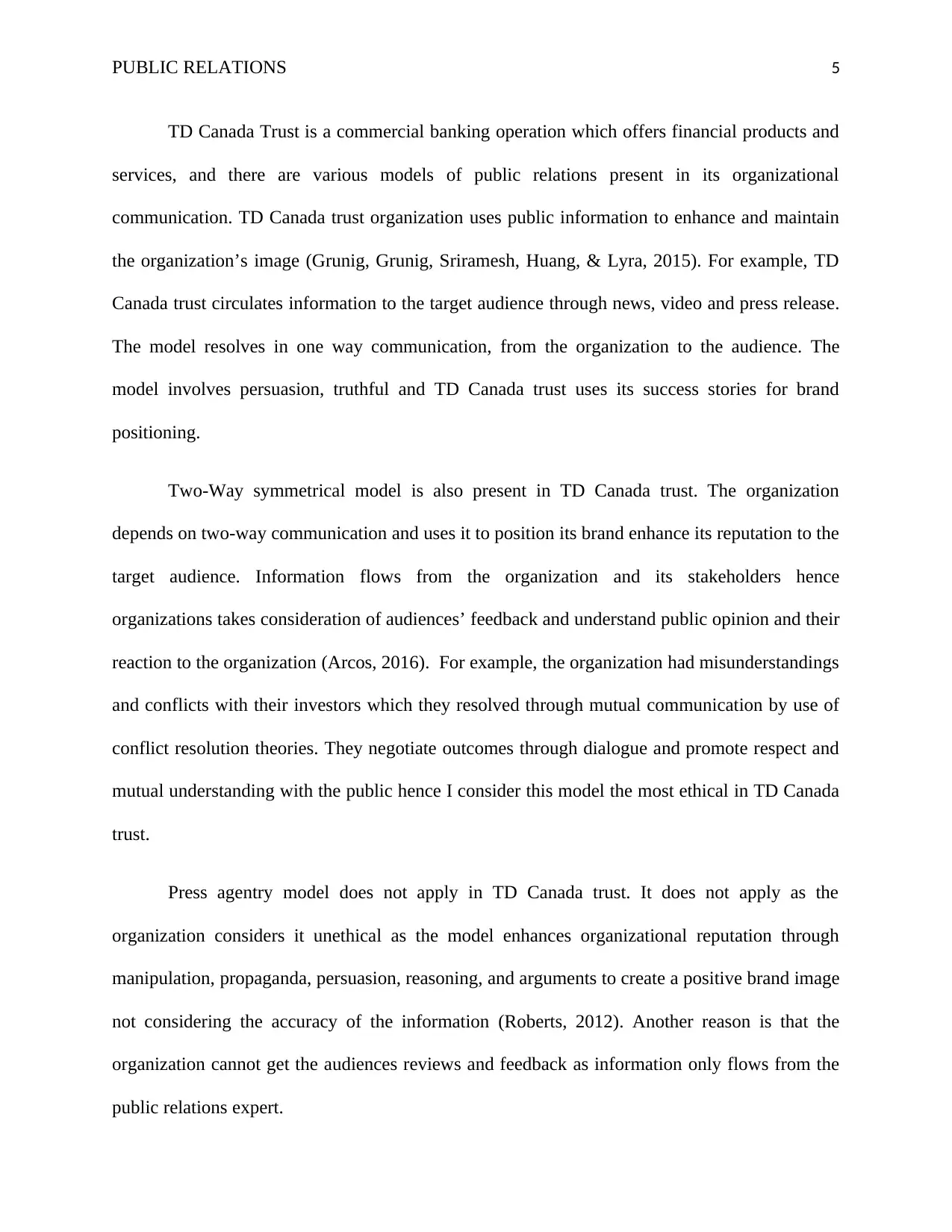
PUBLIC RELATIONS 5
TD Canada Trust is a commercial banking operation which offers financial products and
services, and there are various models of public relations present in its organizational
communication. TD Canada trust organization uses public information to enhance and maintain
the organization’s image (Grunig, Grunig, Sriramesh, Huang, & Lyra, 2015). For example, TD
Canada trust circulates information to the target audience through news, video and press release.
The model resolves in one way communication, from the organization to the audience. The
model involves persuasion, truthful and TD Canada trust uses its success stories for brand
positioning.
Two-Way symmetrical model is also present in TD Canada trust. The organization
depends on two-way communication and uses it to position its brand enhance its reputation to the
target audience. Information flows from the organization and its stakeholders hence
organizations takes consideration of audiences’ feedback and understand public opinion and their
reaction to the organization (Arcos, 2016). For example, the organization had misunderstandings
and conflicts with their investors which they resolved through mutual communication by use of
conflict resolution theories. They negotiate outcomes through dialogue and promote respect and
mutual understanding with the public hence I consider this model the most ethical in TD Canada
trust.
Press agentry model does not apply in TD Canada trust. It does not apply as the
organization considers it unethical as the model enhances organizational reputation through
manipulation, propaganda, persuasion, reasoning, and arguments to create a positive brand image
not considering the accuracy of the information (Roberts, 2012). Another reason is that the
organization cannot get the audiences reviews and feedback as information only flows from the
public relations expert.
TD Canada Trust is a commercial banking operation which offers financial products and
services, and there are various models of public relations present in its organizational
communication. TD Canada trust organization uses public information to enhance and maintain
the organization’s image (Grunig, Grunig, Sriramesh, Huang, & Lyra, 2015). For example, TD
Canada trust circulates information to the target audience through news, video and press release.
The model resolves in one way communication, from the organization to the audience. The
model involves persuasion, truthful and TD Canada trust uses its success stories for brand
positioning.
Two-Way symmetrical model is also present in TD Canada trust. The organization
depends on two-way communication and uses it to position its brand enhance its reputation to the
target audience. Information flows from the organization and its stakeholders hence
organizations takes consideration of audiences’ feedback and understand public opinion and their
reaction to the organization (Arcos, 2016). For example, the organization had misunderstandings
and conflicts with their investors which they resolved through mutual communication by use of
conflict resolution theories. They negotiate outcomes through dialogue and promote respect and
mutual understanding with the public hence I consider this model the most ethical in TD Canada
trust.
Press agentry model does not apply in TD Canada trust. It does not apply as the
organization considers it unethical as the model enhances organizational reputation through
manipulation, propaganda, persuasion, reasoning, and arguments to create a positive brand image
not considering the accuracy of the information (Roberts, 2012). Another reason is that the
organization cannot get the audiences reviews and feedback as information only flows from the
public relations expert.
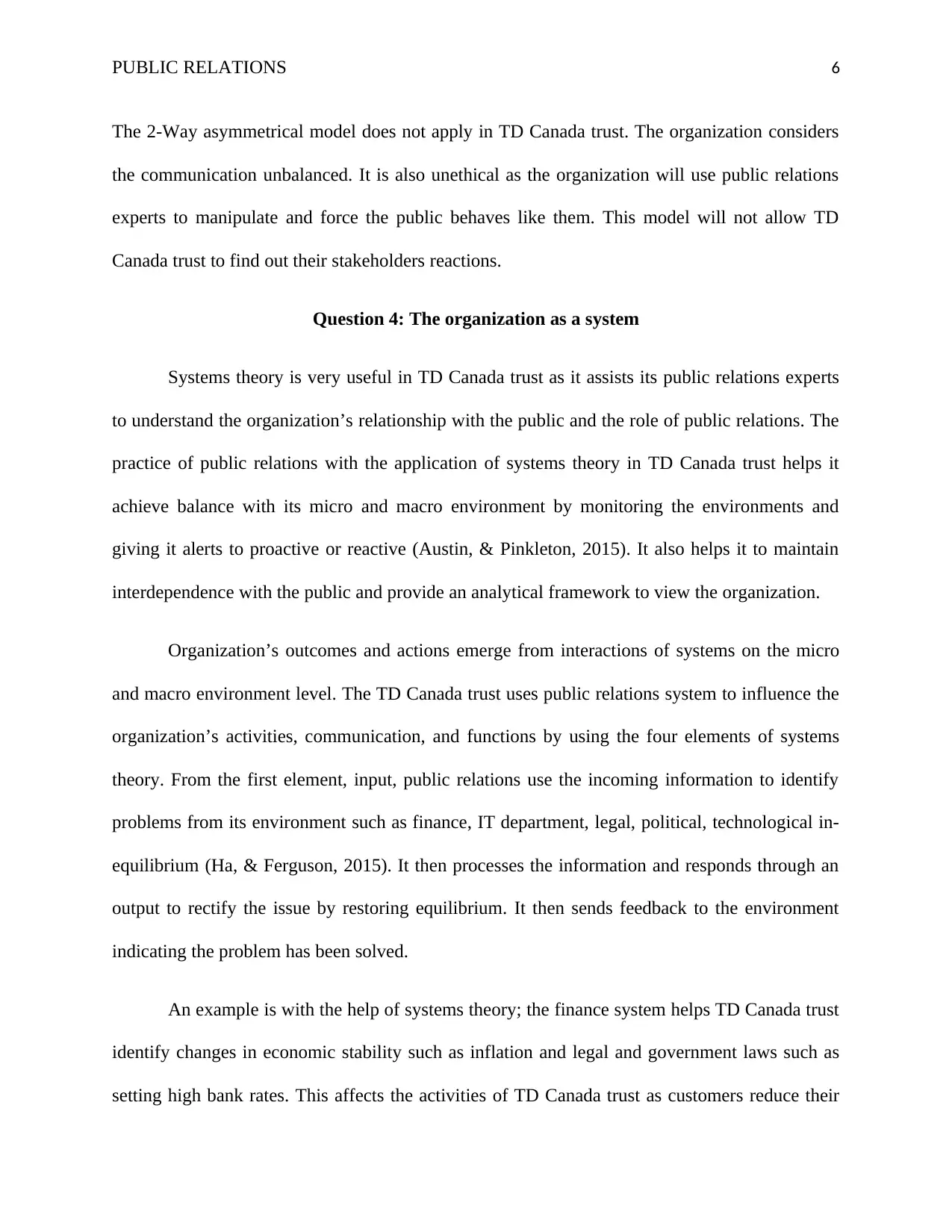
PUBLIC RELATIONS 6
The 2-Way asymmetrical model does not apply in TD Canada trust. The organization considers
the communication unbalanced. It is also unethical as the organization will use public relations
experts to manipulate and force the public behaves like them. This model will not allow TD
Canada trust to find out their stakeholders reactions.
Question 4: The organization as a system
Systems theory is very useful in TD Canada trust as it assists its public relations experts
to understand the organization’s relationship with the public and the role of public relations. The
practice of public relations with the application of systems theory in TD Canada trust helps it
achieve balance with its micro and macro environment by monitoring the environments and
giving it alerts to proactive or reactive (Austin, & Pinkleton, 2015). It also helps it to maintain
interdependence with the public and provide an analytical framework to view the organization.
Organization’s outcomes and actions emerge from interactions of systems on the micro
and macro environment level. The TD Canada trust uses public relations system to influence the
organization’s activities, communication, and functions by using the four elements of systems
theory. From the first element, input, public relations use the incoming information to identify
problems from its environment such as finance, IT department, legal, political, technological in-
equilibrium (Ha, & Ferguson, 2015). It then processes the information and responds through an
output to rectify the issue by restoring equilibrium. It then sends feedback to the environment
indicating the problem has been solved.
An example is with the help of systems theory; the finance system helps TD Canada trust
identify changes in economic stability such as inflation and legal and government laws such as
setting high bank rates. This affects the activities of TD Canada trust as customers reduce their
The 2-Way asymmetrical model does not apply in TD Canada trust. The organization considers
the communication unbalanced. It is also unethical as the organization will use public relations
experts to manipulate and force the public behaves like them. This model will not allow TD
Canada trust to find out their stakeholders reactions.
Question 4: The organization as a system
Systems theory is very useful in TD Canada trust as it assists its public relations experts
to understand the organization’s relationship with the public and the role of public relations. The
practice of public relations with the application of systems theory in TD Canada trust helps it
achieve balance with its micro and macro environment by monitoring the environments and
giving it alerts to proactive or reactive (Austin, & Pinkleton, 2015). It also helps it to maintain
interdependence with the public and provide an analytical framework to view the organization.
Organization’s outcomes and actions emerge from interactions of systems on the micro
and macro environment level. The TD Canada trust uses public relations system to influence the
organization’s activities, communication, and functions by using the four elements of systems
theory. From the first element, input, public relations use the incoming information to identify
problems from its environment such as finance, IT department, legal, political, technological in-
equilibrium (Ha, & Ferguson, 2015). It then processes the information and responds through an
output to rectify the issue by restoring equilibrium. It then sends feedback to the environment
indicating the problem has been solved.
An example is with the help of systems theory; the finance system helps TD Canada trust
identify changes in economic stability such as inflation and legal and government laws such as
setting high bank rates. This affects the activities of TD Canada trust as customers reduce their
⊘ This is a preview!⊘
Do you want full access?
Subscribe today to unlock all pages.

Trusted by 1+ million students worldwide
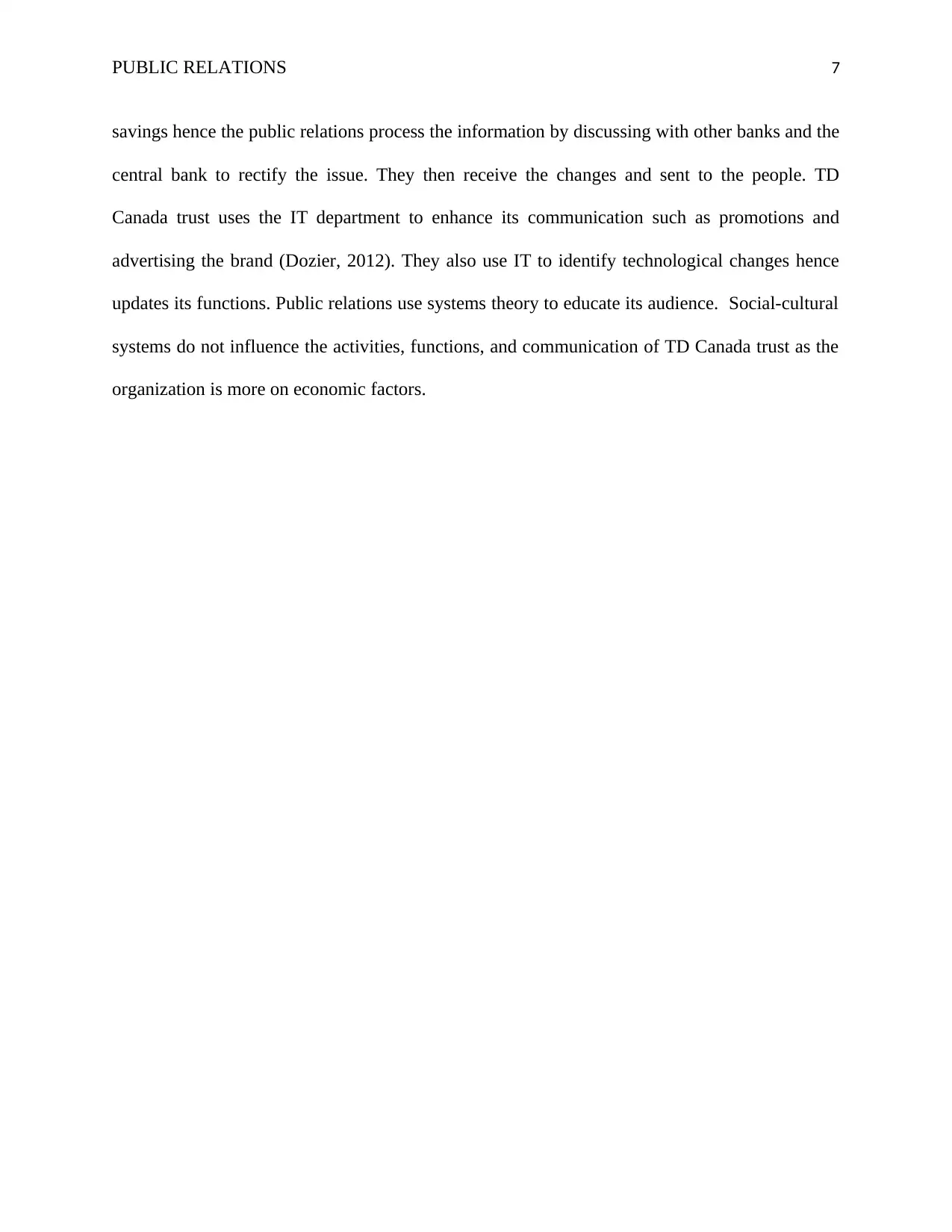
PUBLIC RELATIONS 7
savings hence the public relations process the information by discussing with other banks and the
central bank to rectify the issue. They then receive the changes and sent to the people. TD
Canada trust uses the IT department to enhance its communication such as promotions and
advertising the brand (Dozier, 2012). They also use IT to identify technological changes hence
updates its functions. Public relations use systems theory to educate its audience. Social-cultural
systems do not influence the activities, functions, and communication of TD Canada trust as the
organization is more on economic factors.
savings hence the public relations process the information by discussing with other banks and the
central bank to rectify the issue. They then receive the changes and sent to the people. TD
Canada trust uses the IT department to enhance its communication such as promotions and
advertising the brand (Dozier, 2012). They also use IT to identify technological changes hence
updates its functions. Public relations use systems theory to educate its audience. Social-cultural
systems do not influence the activities, functions, and communication of TD Canada trust as the
organization is more on economic factors.
Paraphrase This Document
Need a fresh take? Get an instant paraphrase of this document with our AI Paraphraser

PUBLIC RELATIONS 8
References
Austin, E. W., & Pinkleton, B. E. (2015). Strategic public relations management: Planning and
managing effective communication campaigns. Routledge, 21(2), 167-172.
Arcos, R. (2016). Public relations strategic intelligence: Intelligence analysis, communication
and influence. Public Relations Review, 42(2), 264-270.
Ha, J. H., & Ferguson, M. A. (2015). Perception discrepancy of public relations functions and
conflict among disciplines: South Korean public relations versus marketing
professionals. Journal of Public Relations Research, 27(1), 1-21.
Lamme, M. O., & Russell, K. M. (2009). Removing the spin: Toward a new theory of public
relations history. Journalism & Communication Monographs, 11(4), 280-362.
Mukhametzhanova, V. S. (2013). Moral and ethical aspects of professionalism. RUDN Journal
of Philosophy, (3), 135-141.
Tsalikis, J., & Fritzsche, D. J. (2016). Business ethics: A literature review with a focus on
marketing ethics. Journal of Business Ethics, 8(9), 695-743.
Beltramini, R. F., Peterson, R. A., & Kozmetsky, G. (2014). Concerns of college students
regarding business ethics. journal of Business Ethics, 3(3), 195-200.
Bowen, S. A. (2014). Expansion of ethics as the tenth generic principle of public relations
excellence: A Kantian theory and model for managing ethical issues. Journal of public
relations research, 16(1), 65-92.
References
Austin, E. W., & Pinkleton, B. E. (2015). Strategic public relations management: Planning and
managing effective communication campaigns. Routledge, 21(2), 167-172.
Arcos, R. (2016). Public relations strategic intelligence: Intelligence analysis, communication
and influence. Public Relations Review, 42(2), 264-270.
Ha, J. H., & Ferguson, M. A. (2015). Perception discrepancy of public relations functions and
conflict among disciplines: South Korean public relations versus marketing
professionals. Journal of Public Relations Research, 27(1), 1-21.
Lamme, M. O., & Russell, K. M. (2009). Removing the spin: Toward a new theory of public
relations history. Journalism & Communication Monographs, 11(4), 280-362.
Mukhametzhanova, V. S. (2013). Moral and ethical aspects of professionalism. RUDN Journal
of Philosophy, (3), 135-141.
Tsalikis, J., & Fritzsche, D. J. (2016). Business ethics: A literature review with a focus on
marketing ethics. Journal of Business Ethics, 8(9), 695-743.
Beltramini, R. F., Peterson, R. A., & Kozmetsky, G. (2014). Concerns of college students
regarding business ethics. journal of Business Ethics, 3(3), 195-200.
Bowen, S. A. (2014). Expansion of ethics as the tenth generic principle of public relations
excellence: A Kantian theory and model for managing ethical issues. Journal of public
relations research, 16(1), 65-92.
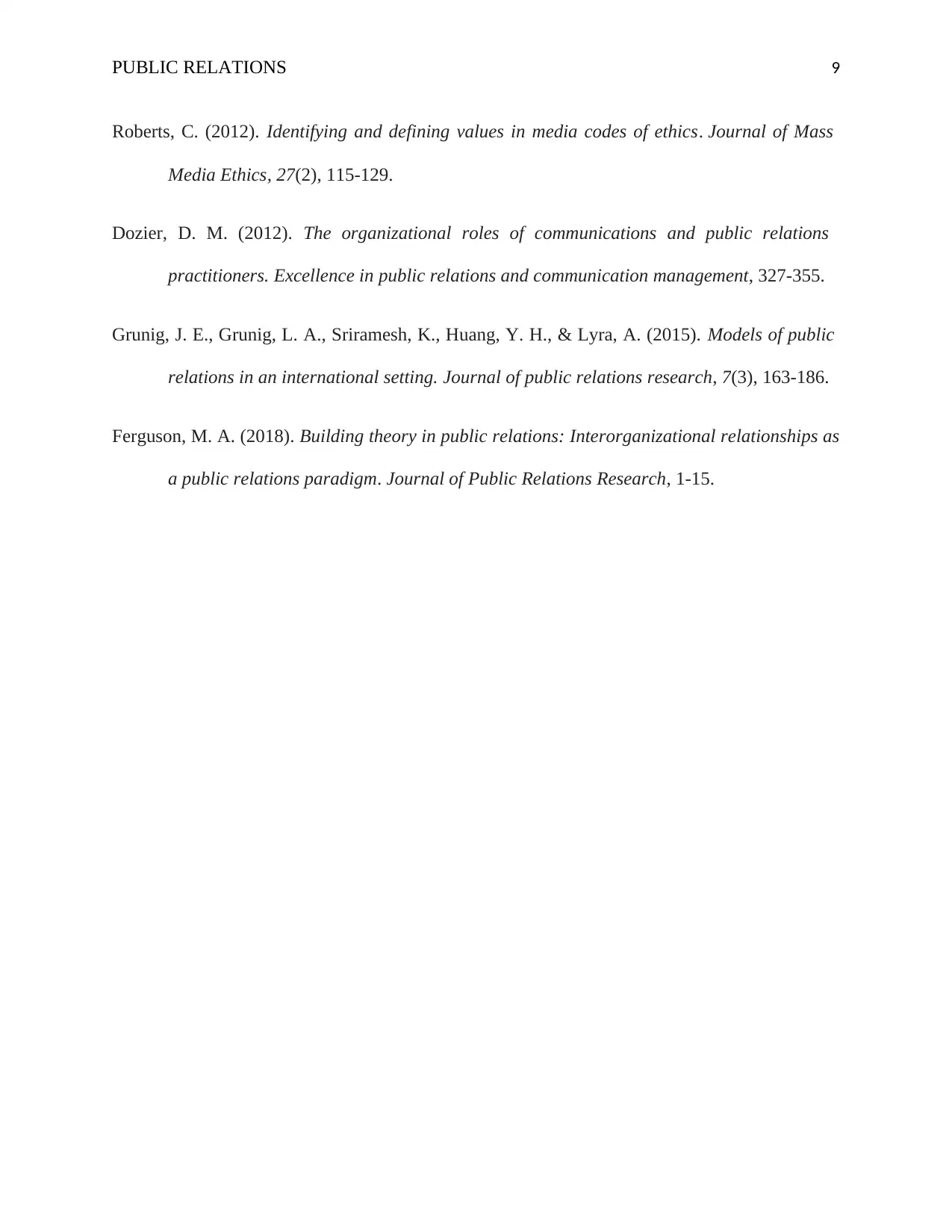
PUBLIC RELATIONS 9
Roberts, C. (2012). Identifying and defining values in media codes of ethics. Journal of Mass
Media Ethics, 27(2), 115-129.
Dozier, D. M. (2012). The organizational roles of communications and public relations
practitioners. Excellence in public relations and communication management, 327-355.
Grunig, J. E., Grunig, L. A., Sriramesh, K., Huang, Y. H., & Lyra, A. (2015). Models of public
relations in an international setting. Journal of public relations research, 7(3), 163-186.
Ferguson, M. A. (2018). Building theory in public relations: Interorganizational relationships as
a public relations paradigm. Journal of Public Relations Research, 1-15.
Roberts, C. (2012). Identifying and defining values in media codes of ethics. Journal of Mass
Media Ethics, 27(2), 115-129.
Dozier, D. M. (2012). The organizational roles of communications and public relations
practitioners. Excellence in public relations and communication management, 327-355.
Grunig, J. E., Grunig, L. A., Sriramesh, K., Huang, Y. H., & Lyra, A. (2015). Models of public
relations in an international setting. Journal of public relations research, 7(3), 163-186.
Ferguson, M. A. (2018). Building theory in public relations: Interorganizational relationships as
a public relations paradigm. Journal of Public Relations Research, 1-15.
⊘ This is a preview!⊘
Do you want full access?
Subscribe today to unlock all pages.

Trusted by 1+ million students worldwide
1 out of 9